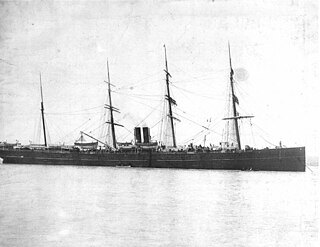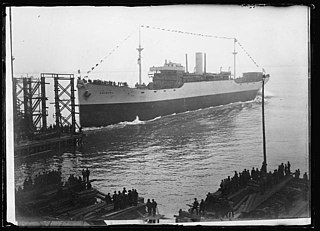Related Research Articles

Chester is a city in Delaware County, Pennsylvania, United States within the Philadelphia Metropolitan Area. It is the only city in Delaware County with a population of 32,605 as of the 2020 Census.

The Bethlehem Steel Corporation was an American steelmaking company headquartered in Bethlehem, Pennsylvania. For most of the 20th century, it was one of the world's largest steel producing and shipbuilding companies. At the height of its success and productivity, the company was a symbol of American manufacturing leadership in the world, and its decline and ultimate liquidation in the late 20th century is similarly cited as an example of America's diminished manufacturing leadership. From its founding in 1857 through its 2003 dissolution, Bethlehem Steel's headquarters and primary steel mill manufacturing facilities were based in Bethlehem, Pennsylvania in the Lehigh Valley region of the United States.

A steel mill or steelworks is an industrial plant for the manufacture of steel. It may be an integrated steel works carrying out all steps of steelmaking from smelting iron ore to rolled product, but may also be a plant where steel semi-finished casting products are made from molten pig iron or from scrap.

Neafie, Levy & Co., commonly known as Neafie & Levy, was a Philadelphia, Pennsylvania shipbuilding and engineering firm that existed from the middle of the 19th to the beginning of the 20th century. Described as America's "first specialist marine engineers", Neafie & Levy was probably the first company in the United States to combine the building of iron ships with the manufacture of steam engines to power them. The company was also the largest supplier of screw propellers to other North American shipbuilding firms in its early years, and at its peak in the early 1870s was Philadelphia's busiest and most heavily capitalized shipbuilder.

The Morgan Iron Works was a 19th-century manufacturing plant for marine steam engines located in New York City, United States. Founded as T. F. Secor & Co. in 1838, the plant was later taken over and renamed by one of its original investors, Charles Morgan.

John Roach was an American industrialist who rose from humble origins as an Irish immigrant laborer to found the largest and most productive shipbuilding empire in the postbellum United States, John Roach & Sons.

SS City of Peking was an iron-hulled steamship built in 1874 by Delaware River Iron Ship Building and Engine Works, Chester, Pennsylvania for the Pacific Mail Steamship Company. City of Peking and her sister ship City of Tokio were at the time of construction the largest vessels ever built in the United States, and the second largest in the world behind the British leviathan Great Eastern.

The Etna Iron Works was a 19th-century ironworks and manufacturing plant for marine steam engines located in New York City. The Etna Works was a failing small business when purchased by ironmolder John Roach and three partners in 1852. Roach soon gained full ownership of the business and quickly transformed it into a successful general-purpose ironworks.
Reaney, Son & Archbold was a 19th-century American iron shipbuilding company located on the Delaware River at Chester, Pennsylvania. The company was established in 1859 by Thomas Reaney but it was undercapitalized from the outset, and like many other American shipbuilding companies, fell victim to the shipbuilding slump that followed the American Civil War.

The Merchant Shipbuilding Corporation was an American corporation established in 1917 by railroad heir W. Averell Harriman to build merchant ships for the Allied war effort in World War I. The MSC operated two shipyards: the former shipyard of John Roach & Sons at Chester, Pennsylvania, and a second, newly established emergency yard at Bristol, Pennsylvania, operated by the MSC on behalf of the U.S. Shipping Board's Emergency Fleet Corporation (EFC).
The Delaware River Iron Ship Building and Engine Works, was a major late-19th-century American shipyard located on the Delaware River in Chester, Pennsylvania. It was founded by the industrialist John Roach and is often referred to by its parent company name of John Roach & Sons, or just known as the Roach shipyard. For the first fifteen years of its existence, the shipyard was by far the largest and most productive in the United States, building more tonnage of ships than its next two major competitors combined, in addition to being the U.S. Navy's largest contractor. The yard specialized in the production of large passenger freighters, but built every kind of vessel from warships to cargo ships, oil tankers, ferries, barges, tugs and yachts.
John Roach & Sons was a major 19th-century American shipbuilding and manufacturing firm founded in 1864 by Irish-American immigrant John Roach. Between 1871 and 1885, the company was the largest shipbuilding firm in the United States, building more iron ships than its next two major competitors combined. It was also by far the largest contractor to the U.S. Navy during this period, and at its peak is said to have been the nation's largest employer behind the railroads.
The Chester Pipe and Tube Company was a company incorporated in 1877 in Chester, Pennsylvania by shipbuilder John Roach for the manufacture of iron pipes and boiler tubes for the steamships built at his Chester shipyard, the Delaware River Iron Ship Building and Engine Works.
The Chester Rolling Mill was a large iron rolling mill established by shipbuilder John Roach in Chester, Pennsylvania, United States in 1873. The main purpose of the Mill was to provide metal hull plates, beams and other parts for the ships built at Roach's Delaware River Iron Ship Building and Engine Works, also located at Chester.
The Standard Steel Casting Company, commonly referred to as Thurlow Works, was a steel production and steel casting facility founded in Chester, Pennsylvania in 1883 by shipbuilder John Roach. The company was established primarily to supply steel ingots for Roach's steel mills, which included the Chester Rolling Mill and the Combination Steel and Iron Company, although it also manufactured steel castings. Standard Steel was the first company in the United States to manufacture commercial quantities of steel utilizing the acid open hearth process.

The Illinois Steel Company was an American steel producer with five plants in Illinois and Wisconsin. Founded through a consolidation in 1889, Illinois Steel grew to become the largest steel producer in the United States. In 1898, several other steel and transportation companies were merged into it to form the Federal Steel Company, itself merged into U.S. Steel in 1901.

The US iron and steel industry has paralleled the industry in other countries in technological developments. In the 1800s, the US switched from charcoal to coal in ore smelting, adopted the Bessemer process, and saw the rise of very large integrated steel mills. In the 20th century, the US industry successively adopted the open hearth furnace, then the basic oxygen steelmaking process. Since the American industry peaked in the 1940s and 1950s, the US industry has shifted to small mini-mills and specialty mills, using iron and steel scrap as feedstock, rather than iron ore.
Skinningrove steelworks is a steel mill in Skinningrove, North Yorkshire, England. The business was formed in 1874 as the Loftus Iron Company, after a liquidation of the company reformed in 1880 as the Skinningrove Iron Company. The works expanded from producing only pig iron to include steel production in the early 20th century, with mills specialising in long products including railway rail. As part of the business the company constructed a jetty at Skinningrove, and owned an ironstone mine in Loftus.

The Lithgow Blast Furnace is a heritage-listed former blast furnace and now park and visitor attraction at Inch Street, Lithgow, City of Lithgow, New South Wales, Australia. It was built from 1906 to 1907 by William Sandford Limited. It is also known as Eskbank Ironworks Blast Furnace site; Industrial Archaeological Site. The property is owned by Lithgow City Council. It was added to the New South Wales State Heritage Register on 2 April 1999.

Bethlehem Key Highway Shipyard started as William Skinner & Sons in downtown Baltimore, Maryland in 1815. In 1899 the shipyard was renamed Skinner Shipbuilding & Dry Dock Company. Also at the site was Malster & Reanie started in 1870 by William T. Malster (1843–1907). In 1879 Malster partnered with William B. Reaney (1808-1883). In 1880 Malster & Reanie was sold and renamed Columbian Iron Works & Dry Dock Company. Malster & Reanie and Skinner Shipbuilding & Dry Dock Company merged in 1906, but remained as Skinner Shipbuilding. In 1914 the company was renamed Baltimore Dry Dock & Shipbuilding Company. Baltimore Dry Dock & Shipbuilding Company sold to Bethlehem Steel in 1922, becoming part of Bethlehem Shipbuilding Corporation. Bethlehem Steel operated the shipyard for ship repair, conversion and some ship construction. Bethlehem main ship construction site was across the harbor at Bethlehem Sparrows Point. Bethlehem Key Highway Shipyard was known as the Bethlehem Upper Yard located north-east side of Federal Hill. Bethlehem Fort McHenry Shipyard located on the west side of Locust Point peninsula was known as the Lower Yard, near Fort McHenry.
References
- Ashmead, Graham Henry (1884): History of Delaware County, Pennsylvania, L. H. Everts & Co., Pennsylvania.
- Swann, Leonard Alexander Jr. (1965): John Roach, Maritime Entrepreneur: the Years as Naval Contractor 1862–1886, United States Naval Institute (reprinted 1980 by Ayer Publishing, ISBN 978-0-405-13078-6).